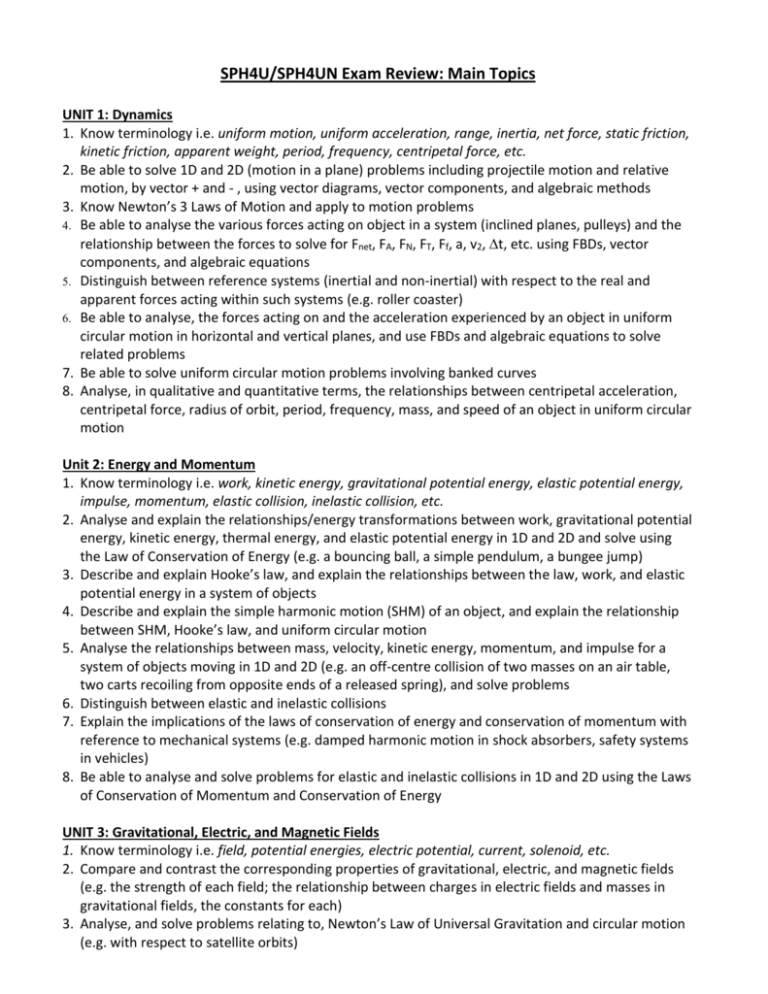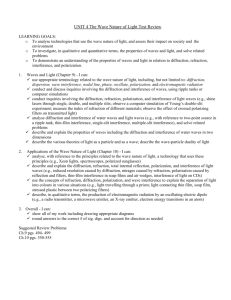SPH4U Exam Review 2013 - Ms. Rousseau`s Classroom
advertisement

SPH4U/SPH4UN Exam Review: Main Topics UNIT 1: Dynamics 1. Know terminology i.e. uniform motion, uniform acceleration, range, inertia, net force, static friction, kinetic friction, apparent weight, period, frequency, centripetal force, etc. 2. Be able to solve 1D and 2D (motion in a plane) problems including projectile motion and relative motion, by vector + and - , using vector diagrams, vector components, and algebraic methods 3. Know Newton’s 3 Laws of Motion and apply to motion problems 4. Be able to analyse the various forces acting on object in a system (inclined planes, pulleys) and the relationship between the forces to solve for Fnet, FA, FN, FT, Ff, a, v2, t, etc. using FBDs, vector components, and algebraic equations 5. Distinguish between reference systems (inertial and non-inertial) with respect to the real and apparent forces acting within such systems (e.g. roller coaster) 6. Be able to analyse, the forces acting on and the acceleration experienced by an object in uniform circular motion in horizontal and vertical planes, and use FBDs and algebraic equations to solve related problems 7. Be able to solve uniform circular motion problems involving banked curves 8. Analyse, in qualitative and quantitative terms, the relationships between centripetal acceleration, centripetal force, radius of orbit, period, frequency, mass, and speed of an object in uniform circular motion Unit 2: Energy and Momentum 1. Know terminology i.e. work, kinetic energy, gravitational potential energy, elastic potential energy, impulse, momentum, elastic collision, inelastic collision, etc. 2. Analyse and explain the relationships/energy transformations between work, gravitational potential energy, kinetic energy, thermal energy, and elastic potential energy in 1D and 2D and solve using the Law of Conservation of Energy (e.g. a bouncing ball, a simple pendulum, a bungee jump) 3. Describe and explain Hooke’s law, and explain the relationships between the law, work, and elastic potential energy in a system of objects 4. Describe and explain the simple harmonic motion (SHM) of an object, and explain the relationship between SHM, Hooke’s law, and uniform circular motion 5. Analyse the relationships between mass, velocity, kinetic energy, momentum, and impulse for a system of objects moving in 1D and 2D (e.g. an off-centre collision of two masses on an air table, two carts recoiling from opposite ends of a released spring), and solve problems 6. Distinguish between elastic and inelastic collisions 7. Explain the implications of the laws of conservation of energy and conservation of momentum with reference to mechanical systems (e.g. damped harmonic motion in shock absorbers, safety systems in vehicles) 8. Be able to analyse and solve problems for elastic and inelastic collisions in 1D and 2D using the Laws of Conservation of Momentum and Conservation of Energy UNIT 3: Gravitational, Electric, and Magnetic Fields 1. Know terminology i.e. field, potential energies, electric potential, current, solenoid, etc. 2. Compare and contrast the corresponding properties of gravitational, electric, and magnetic fields (e.g. the strength of each field; the relationship between charges in electric fields and masses in gravitational fields, the constants for each) 3. Analyse, and solve problems relating to, Newton’s Law of Universal Gravitation and circular motion (e.g. with respect to satellite orbits) 4. Analyse and solve problems related to orbits and Kepler’s 3 Laws of Planetary Motion 5. Explain differences, using field diagrams, in the sources and directions of fields, including, differences between near-Earth and distant fields, parallel plates and point charges, straight line conductors and solenoids 6. Analyse, and solve problems for electric force using Coulomb’s Law, field strength, electric potential, and electric potential energy as they apply to uniform and non-uniform electric fields (e.g. the fields produced by a parallel plate and by point charges) 7. Be able to solve problems using work and Conservation of Energy for electric potential energy and kinetic energy 8. Discuss the behaviour of a particle in a field (e.g. Coulomb’s law; Millikan’s experiment with elementary particles) 9. Be able to solve problems for the force on charges moving in a uniform magnetic field (e.g. the force on a current-carrying conductor or a free electron) 10. Analyse and solve problems using the RHR (conventional current + → - ) and LHR (e- flow - → +) UNIT 4: The Wave Nature of Light 1. Know terminology i.e. wavelength, constructive and destructive interference, diffraction, dispersion, wave interference, nodal line, phase, oscillate, polarization, electromagnetic radiation, etc. 2. Describe and explain the diffraction and interference of water waves in 2D 3. Explain, with reference to the principles related to the wave nature of light, a technology that uses these principles (e.g. polarized sunglasses, fibre optics) 4. Analyse diffraction and interference of water waves and light waves (in a two-point source interference in a ripple tank, thin-film interference, single-slit interference), and solve related problems 5. Describe and explain the diffraction, refraction, polarization, and interference of light waves (e.g. reduced resolution caused by diffraction, mirages caused by refraction, polarization caused by reflection and filters, thin-film interference in soap films and air wedges, interference of light on CDs) 6. Use the concepts of refraction, diffraction, polarization, and wave interference to explain the separation of light into colours in various situations (e.g. light travelling through a prism; light contacting a thin film, soap film, etc.) 7. Compare and contrast experimental evidence and ideas that supported a particle model of light and a wave model of light 8. Describe, in qualitative terms, the production of electromagnetic radiation by an oscillating electric dipole (e.g. a radio transmitter, a microwave emitter, an X-ray emitter, etc.) UNIT 5: Modern Physics – Quantum Mechanics and Special Relativity 1. Know terminology i.e. relativity, simultaneity, time dilation, proper time, etc. 2. Identify Einstein’s two postulates for the Theory of Special Relativity, and describe the evidence supporting the theory 3. Solve relativistic problems related to Einstein’s theory of special relativity in order to calculate the effects of relativistic motion on time, length, and mass 4. Compare proper time and time for an object moving at a percentage of the speed of light 5. Explain simultaneity using examples 6. Explain the twin paradox with examples Remember Show all of your work! No work = no marks Watch your units (use conversions as needed) Round the final answer only; carry through at least 4 decimal places Be sure to draw diagrams when needed; these may be worth marks SIG DIGS! Be careful - a maximum of 3 marks can be lost on exam List any assumptions that you need to make All formulae and constants will be provided on the last page of your exam Suggested Review Problems (answers are located in back of text) Chapters 1-11 You should study from: your tests your notes including assigned HW problems text review summary of each chapter suggested chapter review problems if you have time, check out the Unit Reviews also For the exam you will need: 2 pencils (for scantron card), eraser, calculator, and a ruler. Theory Questions 1. Explain, using examples the difference between inertial and non-inertial frames of reference. 2. Explain the theory behind banked ramps on highways. 3. Explain how a roller coaster loop works. 4. Discuss simple harmonic motion using examples. 5. State and explain the Law of Conservation of Momentum. 6. State and explain the Law of Conservation of Energy. 7. Explain the three methods of charging. 8. Explain the three RHR (right-hand rules). 9. Explain the principles behind Faraday’s iron ring. 10.Discuss the 2 main theories proposed for the nature of light. 11.Distinguish between interference and diffraction. 12.Discuss how polarization works with respect to sunglasses. 13.Explain simultaneity using examples. 14.Discuss Einstein’s Theory of Special Relativity. 15.Discuss the relativistic effects of travelling close to the speed of light.









